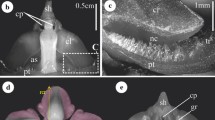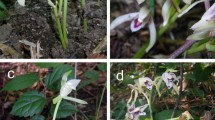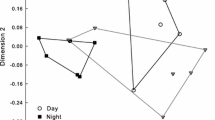Abstract
Orchids attach their pollinaria (cohesive masses of pollen) to specific body parts of flower visitors, but usually not to the hairy and scaly body parts of flower-visiting moths, because hairs and scales are easily detached. We demonstrate that pollinaria of Habenaria sagittifera (Orchidaceae) are transferred among flowers on the hairy thoraxes of moths in Japan. Diurnal and nocturnal insects visited the orchid flowers. However, pollinaria were attached only to the hairy thoraxes of plusiine moths (Lepidoptera: Noctuidae). All pollinaria were directly attached to the ventral thorax surfaces at the bases of hairs. Orchid spur lengths matched plusiine proboscis lengths so that nectar-feeding moths contacted the viscidia (sticky pads of pollinaria) and stigma. Other flower visitors did not contact the viscidia or stigmas while feeding on nectar. Habenaria sagittifera appears to have a floral morphology that is adaptive for the transfer of pollinaria on the thoraxes of plusiine moths.


Similar content being viewed by others
References
Broström G (2019) glmmML: generalized linear models with clustering. https://cran.r-project.org/web/packages/glmmML/. Accessed 16 Aug 2019
Chase MW, Cameron KM, Freudenstein JV, Pridgeon AM, Salazar G, van den Berg C, Schuiteman A (2015) An updated classification of Orchidaceae. Bot J Linn Soc 177:151–174
de Merxem DG, Borremans B, de Jäger ML, Johnson T, Jooste M, Ros P, Zenni RD, Ellis AG, Anderson B (2009) The importance of flower visitors not predicted by floral syndromes. S Afr J Bot 75:660–667
Eisner T, Alsop R, Ettershank G (1964) Adhesiveness of spider silk. Science 146:1058–1061
Esposito F, Merckx T, Tyteca D (2017) Noctuid moths as potential hybridization agents for Platanthera orchids. Lankesteriana 17:383–393
Inoue K (1986) Experimental studies on male and female reproductive success: effects of variation in spur length and pollinator activity on Platanthera mandarinorum ssp. hachijoenesis (Orchidaceae). Plant Species Biol 1:207–215
Johnson SD, Edwards TJ (2000) The structure and function of orchid pollinaria. Plant Syst Evol 222:243–369
Kishida Y (2011a) The standard of moths in Japan 1. Gakken Education Publishing, Tokyo
Kishida Y (2011b) The standard of moths in Japan 2. Gakken Education Publishing, Tokyo
Ministry of the Environment of Japan (2017) Red data books and lists. ikilog.biodic.go.jp/Rdb/booklist (accessed 22 November 2018)
Moré M, Amorim FW, Benitez-Vieyra S, Medina AM, Sazima M, Cocucci AA (2012) Armament imbalances: match and mismatch in plant-pollinator traits of highly specialized long-spurred orchids. PLoS ONE 7:e41878
Nasu Y, Hirowatari T, Kishida Y (2013) The standard of moths in Japan 4. Gakken Education Publishing, Tokyo
Nilsson LA (1983) Processes of isolation and introgressive interplay between Platanthera bifolia (L.) Rich and P. chlorantha (Custer) Reichb. (Orchidaceae). Bot J Linn Soc 87:325–350
Nilsson LA (1988) The evolution of flower with deep corolla tubes. Nature 334:147–149
Ohashi H, Kadota Y, Murata J, Yonekura K, Kihara H (2015) Wild flowers of Japan. vol. 1 Cycadaceae~Cyperaceae. Heibonsha, Tokyo
Ollerton J, Winfree R, Tarrant S (2011) How many flowering plants are pollinated by animals? Oikos 120:321–326
Pauw A (2006) Floral syndromes accurately predict pollination by a specialized oil-collecting bee (Rediviva peringueyi, Melittidae) in a guild of South African orchids (Coryciinae). Am J Bot 93:917–926
Pedron M, Buzatto CR, Singer RB, Batista JAN, Moser A (2012) Pollination biology of four sympatric species of Habenaria (Orchidaceae: Orchidinae) from southern Brazil. Bot J Linn Soc 170:141–156
Peter CI, Coombs G, Huchzermeyer CF, Venter N, Winkler AC, Hutton D, Papier LA, Dold AP, Johnson SD (2009) Confirmation of hawkmoth pollination in Habenaria epipactidea: leg placement of pollinaria and crepuscular scent emission. S Afr J Bot 75:744–750
Proctor M, Yeo P, Lack A (1996) The natural history of pollination. Timber Press, Portland
R Development Core Team (2017) R: a language and environment for statistical computing. R Foundation for Statistical Computing, Vienna
Singer RB (2001) Pollination biology of Habenaria parviflora (Orchidaceae: Habenariinae) in southeastern Brazil. Darwiniana 39:201–207
Singer R, Cocucci AA (1997) Eye attached hemipollinaria in the hawkmoth and settling moth pollination of Habenaria (Orchidaceae): a study on functional morphology in 5 species from subtropical South America. Botanica Acta 110:328–337
Singer RB, Breier TB, Flach A, Farias-Singer R (2007) The pollination mechanism of Habenaria pleiophylla Hoehne & Schlechter (Orchidaceae: Orchidinae). Funct Ecosyst Communities 1:10–14
Suetsugu K, Tanaka K (2014) Consumption of Habenaria sagittifera pollinia by juveniles of the katydid Ducetia japonica. Entomol Sci 17:122–124
Sugiura S, Yamazaki K (2005) Moth pollination of Metaplexis japonica (Apocynaceae): pollinaria transfer on the tip of the proboscis. J Plant Res 118:257–262
Tao ZB, Ren ZX, Bernhardt P, Wang WJ, Liang H, Li HD, Wang H (2018) Nocturnal hawkmoth and noctuid moth pollination of Habenaria limprichtii (Orchidaceae) in sub-alpine meadows of the Yulong Snow Mountain (Yunnan, China). Bot J Linn Soc 187:483–498
Terayama M, Suda H (eds) (2016) A guide to the aculeate wasps of Japan. Tokai University press, Kanagawa
Acknowledgments
We thank S. Miyake, D. Tochimoto, M. Nishiura, and K. Hotta for providing valuable information about the study site. We also thank D. Funamoto and K. Suetsugu for providing helpful research advice. We thank anonymous reviewers for the helpful comments on the early version of our manuscript.
Funding
This research was partly supported by the JSPS KAKENHI Grant Number JP 19J20396.
Author information
Authors and Affiliations
Corresponding authors
Additional information
Communicated by: Matthias Waltert
Publisher’s note
Springer Nature remains neutral with regard to jurisdictional claims in published maps and institutional affiliations.
Electronic supplementary material
ESM 1
(PDF 507 kb).
Rights and permissions
About this article
Cite this article
Sakagami, K., Sugiura, S. Noctuid moths as pollinators of Habenaria sagittifera (Orchidaceae): floral adaptations for the transfer of pollinaria on the thoraxes of moths. Sci Nat 106, 58 (2019). https://doi.org/10.1007/s00114-019-1652-7
Received:
Revised:
Accepted:
Published:
DOI: https://doi.org/10.1007/s00114-019-1652-7




